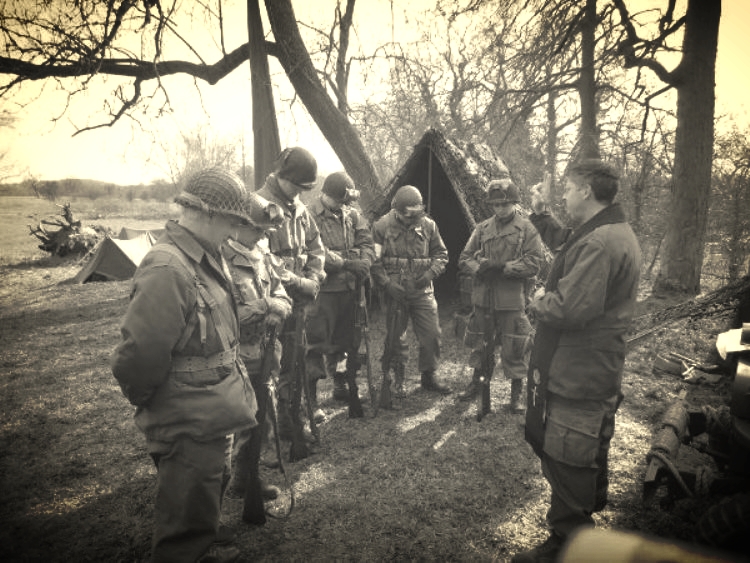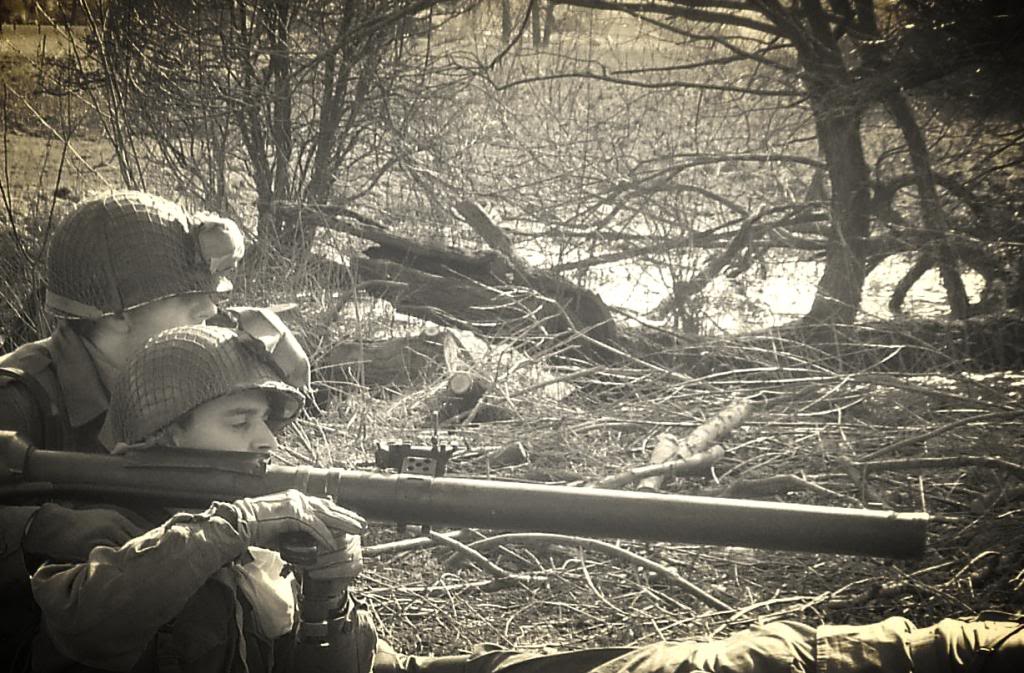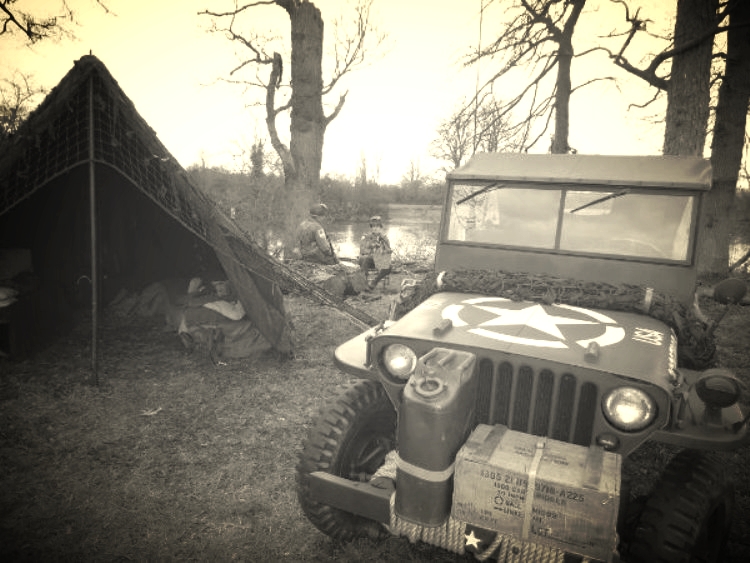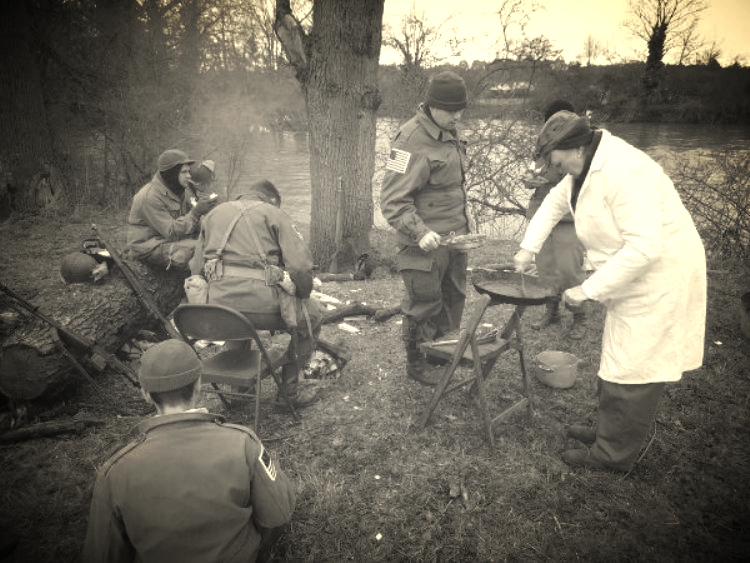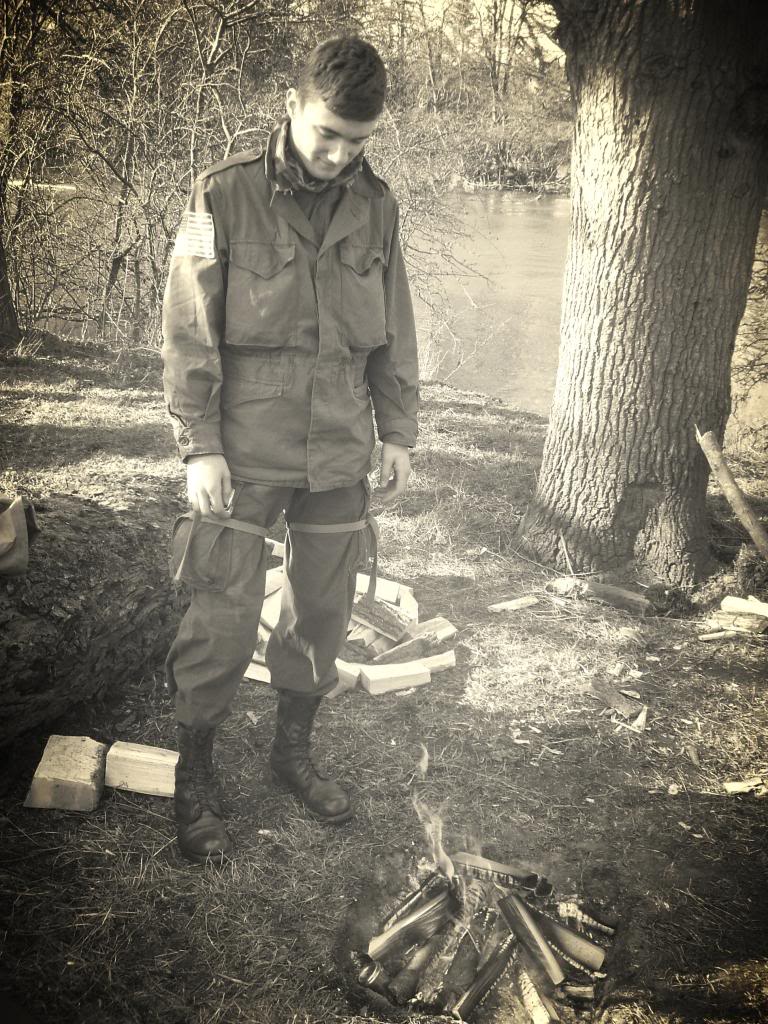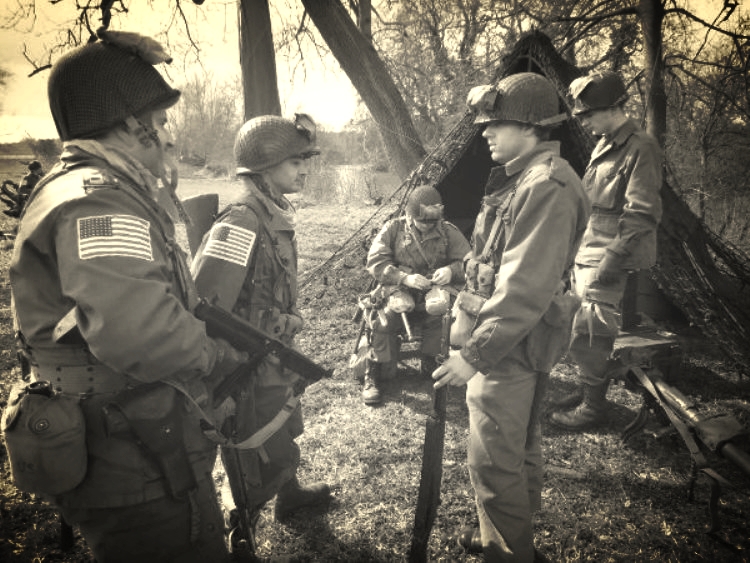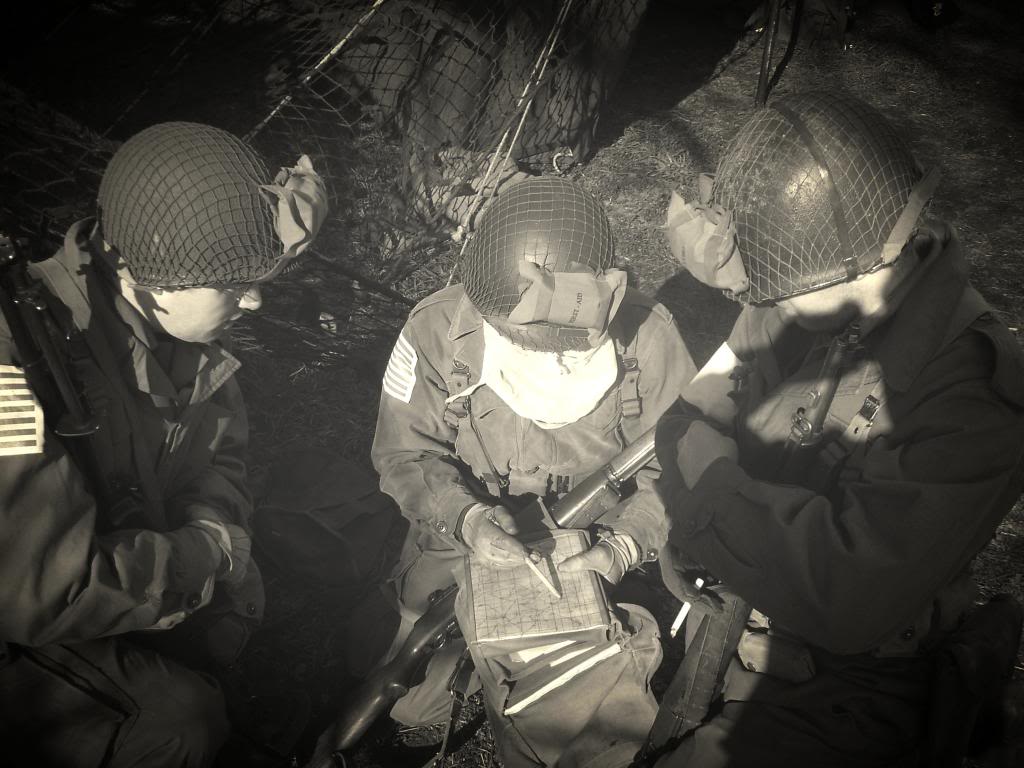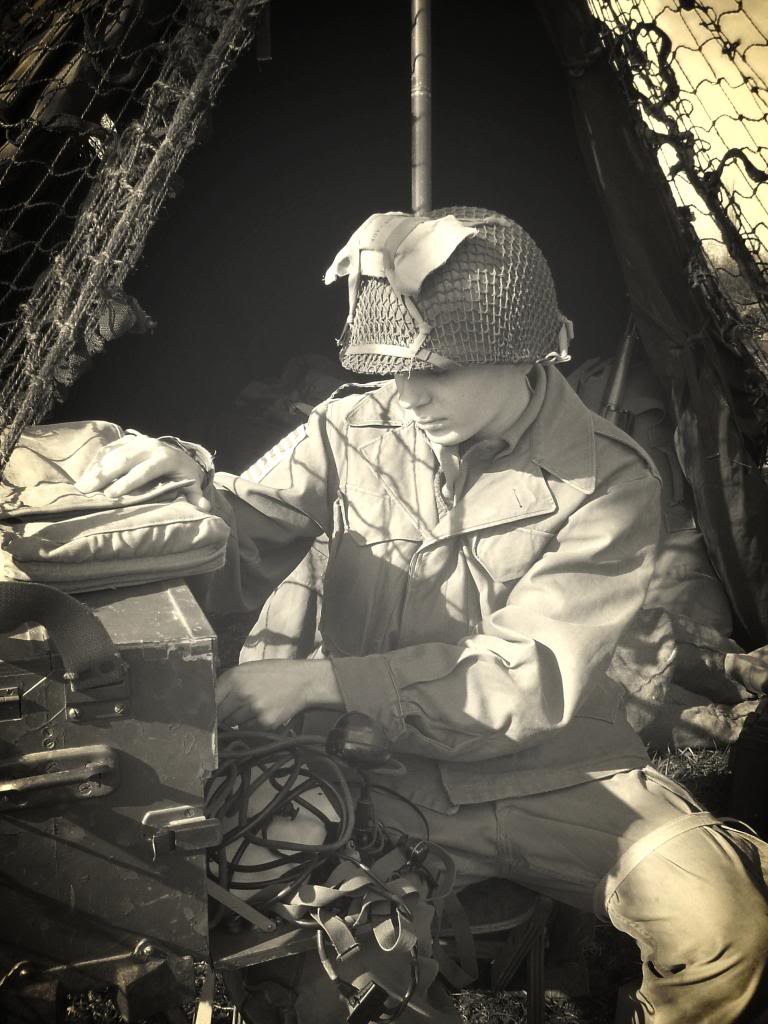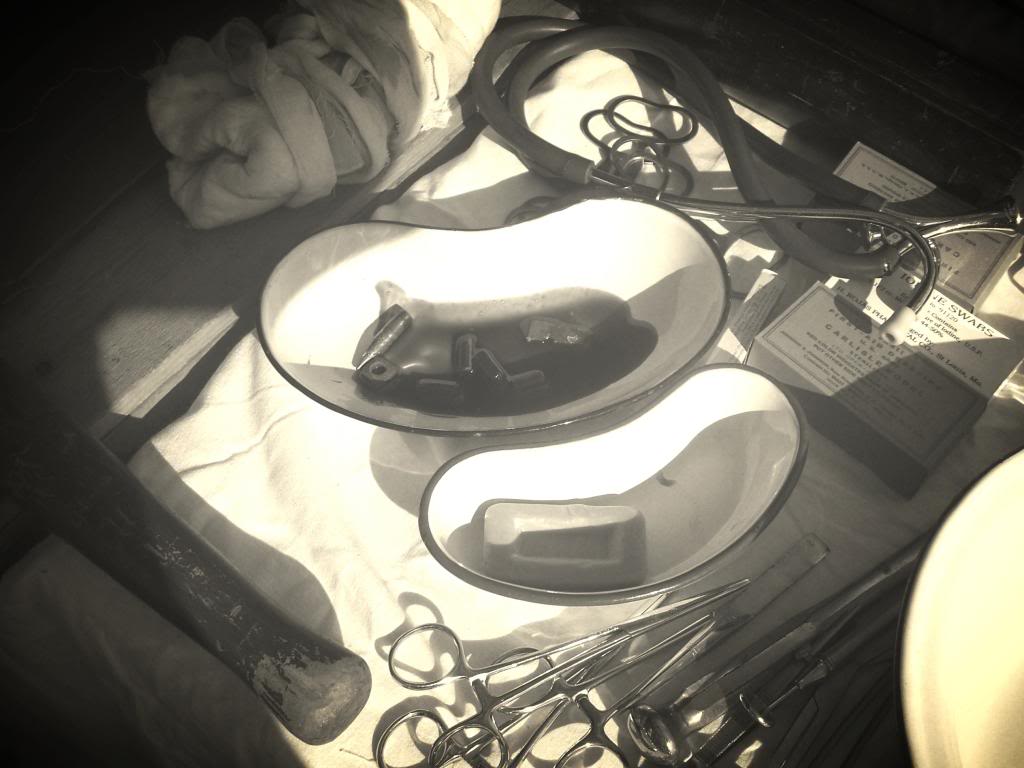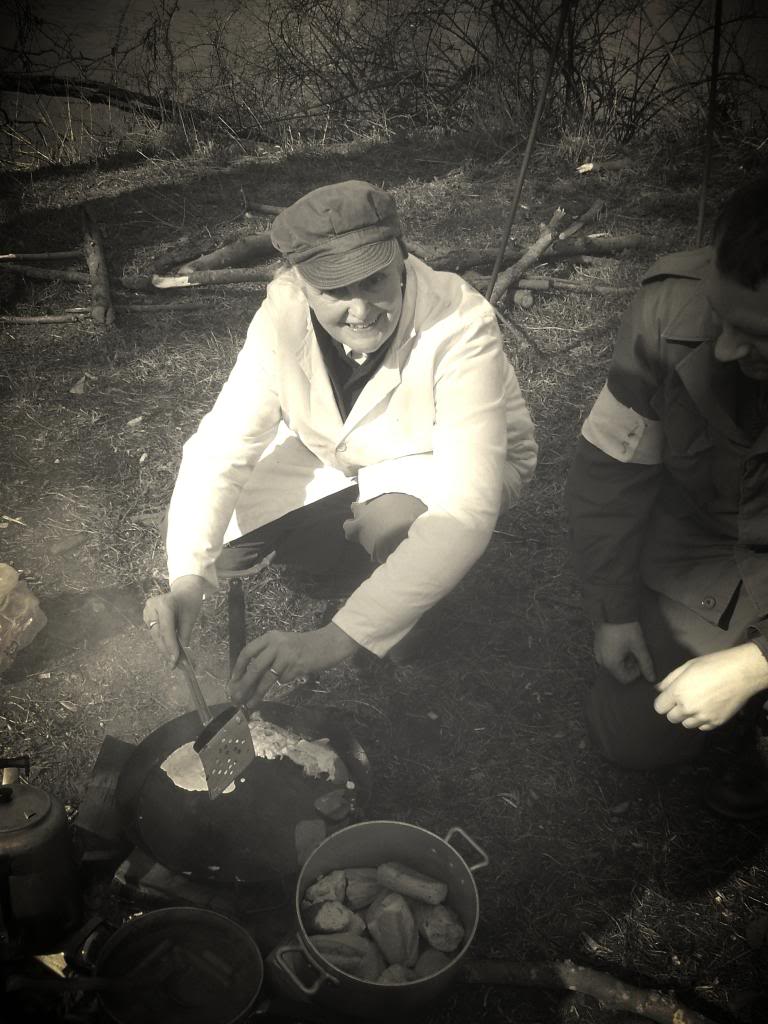MAPPLEDURHAM AT WAR
Page 1 sur 1
 MAPPLEDURHAM AT WAR
MAPPLEDURHAM AT WAR
In March the group deployed on its first field event, to Mapledurham for the new Mapledurham at War Show. This coincided with the Operation Varsity dates and the group decided to, once again, represent the 17th Airborne Division. Whilst it had been some time since the group had represented this fine division, it was the FAAA (many years back) that first adopted this unit as one of its main impressions, and ever since many of the group have taken special delight in displaying as the 17th.
Mapledurham was the film location for the 70's WWII classic, The Eagle Has Landed.
http://www.movie-locations.com/movies/e/eaglehaslanded.html
For this show in particular, it was decided to represent the unit at division level and supported the event deploying as Headquarters and Headquarters Company, 17th Airborne Division. the display was based around divisional headquarters and the division message centre and aid post. the venue, as has already been reported, was outstanding - probably one of the very best we have ever had. Thanks must go to Dave and his team for allowing us, first of all to take part in the event, and also to select a display location with the River Thames back drop, allowing us to faithfully recreate a scene from the Varsity jump using the Thames to represent the eastern bank of the Rhine near the village of Hamminkeln and the town of Wesel., Germany March 1945.
the event, for us, was one of the most friendliest and well organised event that we have attended in many years. We have always thought that the smaller events, as far as we are concerned, provide us with the quality public shows that we want to do. the groups we displayed alongside were extremely high quality and interacted with each other during the set piece scenarios that were required for the public.
Although we never got involved with the public battle, as public and private battles are not really our bag, we did provide a short, rehearsed scenario for the public which involved a short scene depicting a patrol coming into Headquarters with a captured German. We were very fortunate to bump into a personal friend of ours who had travelled from Germany for the show. "Lucky", whose Father served with a German mountain ski unit in WWII, provided us with a realistic captured German soldier. During our scenario he was interrogated by one of our German speaking group members, which came across as very realistic as far as the public were concerned. the scenario finished with the German soldier being manhandled into the Jeep trailer and driven off at speed towards allied forces and captivity.
The pictures below can be used to tell a bit of the story......
Operation Varsity, the Allied airborne assault over the Rhine River at Wesel, Germany, on March 24, 1945, is one of those military actions whose value has sometimes been questioned. American forces had already crossed the Rhine at two locations when Field Marshal Bernard Law Montgomery mounted his assault in the north. Some have speculated that the airborne phase of the assault may have been unnecessary for the success of the overall operation. Montgomery has been accused of using the airborne troops to 'put on a good show' and to further his own reputation.
Regardless the First Allied Airborne Association who have for many years had a group and individual interest in this Campaign and the American troops involved in the operation once again represented the 17th Airborne Division at an event to commemorate the last Airborne operation of WWII
With the interest in Normandy and Market Garden the Varsity operation and many of the later ground campaigns are largely forgotten about in history and often in the Living History World, however the War had not yet been won in March 1945 and much fighting and loss of life was yet to take place. The First Allied Airborne Association used its invite to the Mappledurham event to commemorate in their way the war into Germany.
The Campaign is as interesting as it is complicated, for some time before Allied forces reached the Rhine, Allied Supreme Commander Dwight D. Eisenhower's headquarters had been working on a plan called Operation Eclipse. It was a daring plan, including an airborne assault on Berlin itself. Before it could be put into action, however, Montgomery's Twenty-first Army Group would have to cross the Rhine in the north, trapping the Germans between his forces and those of Hodges and Patton driving in from the south. With the enemy caught in that vice, Eisenhower figured the time would be ripe for a daring operation like Eclipse, which could probably end the war.
Eisenhower rather reluctantly agreed to Montgomery's plan for crossing the Rhine, code-named 'Plunder,' which would be second in size only to the Normandy invasion. Operation Varsity, the airborne phase of Plunder, would include the British 6th Airborne Division 'Red Devils,' commanded by Maj. Gen. Eric L. Bols, and the U.S. 17th Airborne Division 'Thunder From Heaven,' commanded by Maj. Gen. William 'Bud' Miley, in the largest airborne drop made in a single day and would establish many other airborne warfare records that remain unchallenged.
The 6th Airborne troopers were veterans of the D-Day drop in Normandy, but Varsity would be the 17th Airborne's first airborne combat assault. The American paratroopers had already distinguished themselves as a battle-tough outfit, however. Before Christmas 1944, the 17th had been rushed to the Continent from its bases in England and had seen heavy combat during the German Ardennes offensive.
Operation Plunder was set in motion on the night of March 22, 1945, just as Montgomery had planned, and the land elements began to move toward the Rhine. A giant smoke screen, which hid the Allied movements from enemy observation, blanketed the area for miles and soon hindered those movements. It later caused problems for the airborne troops' landing as well.
As the massive operation got underway, the airborne troopers were in their marshalling areas, being briefed on their mission. The Americans would take off from 17 airfields in north-central France; the British were slated to leave from 11 airfields in south-eastern England. The Douglas C-47 and Curtiss C-46 transport aircraft were poised and ready. The gliders were neatly placed on the runways, awaiting connection to their tugs. All awaited the coded signal to go: 'Two if by sea.' In the marshalling areas troops of the 17th Airborne kept busy, the men prepared for battle, cleaning their weapons, sharpening their knives and otherwise readying their equipment for the task ahead.
The Paratroopers and Glider men kept active to ease the tension and instill the fighting spirit, heads were shaved and Mohawks cut, the airborne troops were ready for battle. However all that preparation had not gone unnoticed by the German high command? Accordingly, the German commanders had moved additional troops and a number of new anti-aircraft units into the area and taken special steps to fortify all potential landing zones. Axis Sally, the 'Berlin Bitch' as the GIs called her, even announced in her nightly radio propaganda broadcast that the Germans were expecting the 17th Airborne, and she promised them a hot reception. The chaplains held services, and most everyone attended.
Early on the morning of March 24, the signal, 'Two if by sea,' was flashed to General Miley's headquarters, and the airborne operation jumped into high gear. The troopers were served a breakfast of steak and eggs, and then geared up and were loaded into trucks for the ride to the planes.
The troops were quiet and determined — from here on out, it would be very serious business. The overall mission for the airborne troopers sounded quite simple. They were to seize the bridges over the Issel River and rapidly clear the enemy from the Diersfordter Forest. That would facilitate the ground forces' river crossing and prevent enemy reinforcements from reaching the beachhead. After the crossing was secure, the ground elements would move forward, and the troopers were to join them in the push into Germany, keeping the Germans on the run.
The 17th Airborne was to land in the southern portion of the XVIII Airborne Corps zone, and the British 6th Airborne was headed for the northern portion. The entire area was only 5 miles deep and 6 miles wide, and a total of nearly 18,000 airborne troops had to be inserted, making the airhead east of the Rhine the most congested airborne assault ever attempted at that time.
Lieutenant General Miles Dempsey, commander of the British Second Army, was in charge of the land element crossing the Rhine by boat. Commandos had already slipped across during the night of March 23 and were engaged near Wesel. Other ground forces would cross the Rhine under cover of darkness early on March 24. The airborne troops would drop a few hours later, after daylight. The supply and administrative units of the 17th Airborne were to cross by LVTs (landing vehicles, tracked) — amphibious personnel carriers the British called 'Buffaloes' — once the beachhead was secure.
A total of 9,387 men of the 17th Airborne Division were transported in 72 C-46s and 226 C-47s, while 610 C-47s towed 906 Waco CG-4A gliders. The British lift consisted of more than 8,000 men aboard 42 Douglas C-54s and 752 C-47s, with 420 Airspeed Horsa and General Aircraft Hamilcar gliders. In all, the sky train stretched nearly 200 miles and took two hours and 37 minutes to pass any given point. A protective blanket of 676 fighters from the U.S. Ninth Air Force and 213 fighters of the Royal Air Force escorted the armada. The first planes carrying soldiers of the 17th Airborne took off at 7:17 a.m., and the last lifted off at 8:58. While the troop planes circled overhead, the gliders and their tows lifted off. Inside the troop planes and in the gliders the men settled down for the flight to the drop areas. The British and American flights met up near Brussels, Belgium. From there on it was a straight, 100-mile run to the drop areas, four to six miles east of the Rhine.
As the aircraft neared the Rhine River, the men saw troops below crossing in assault boats and a build up of men and supplies waiting to cross. As the planes came into view, the Allied artillery bombardment of the German positions on the east side was halted as a precaution — but German anti-aircraft fire soon opened up on the airborne convoy. Black shell bursts dotted the sky, and red tracer bullets arced up, reaching for the planes. The troopers watched with horror as first one then another troop plane nosed over and headed down. Paratroopers and glider troops alike were anxious to get on the ground, where they felt they had a fighting chance.
The new double-door C-46s, used for the first time to drop paratroopers in combat, did not have self-sealing fuel tanks. When the tanks were hit, the gasoline burst into flames that ran back along the fuselage. As the planes began to burn, the pilots bravely fought to hold them level as they continued to search for their drop zones and tried to give the paratroopers an opportunity to get clear of the aircraft. Colonel Raff and some 500 of his paratroopers were dropped two miles northeast of their drop zone. Raff rounded up his troops and led them off on the double toward their objectives. The remainder of the regiment, plus Edward S. Branigan's 464th Field Artillery Battalion, landed almost directly on their assigned targets. The troopers moved swiftly, and all of their objectives were taken.
Private George J. Peters of G Company, 507th Parachute Infantry, was the only other man to receive the Medal of Honor for actions that day. Peters single-handedly charged and wiped out a German machine-gun nest that threatened his squad. The 513th jumped into the British 6th Airborne's drop zone instead of its own. The troopers quickly assembled, cleared the British area of Germans and proceeded to their own objectives. By 2 p.m., only two hours after they had landed, Coutts was able to report to General Miley that the regiment's objectives were secured.
As they approached their landing zones, the 194th Glider Infantry Regiments glider tug planes had no choice but to fly a straight course. The glider pilots were already struggling to maintain control of their flimsy craft; if the tug pilots took evasive action to avoid the deadly ground fire, their two glider tows might crash into each other. If they increased their speed, the gliders could break up or become uncontrollable. This was the first time the double tows had been used in a combat operation.
To make matters worse, the last glider group was forced to climb to around 2,500 feet due to a stack up of traffic over its landing zone. The gliders released at that altitude established a new height record for combat release. But the glider pilots knew that it would take longer for them to reach the ground, giving the Germans longer to shoot at the fat, slow targets.
The smoke screen, several miles long by the time the airborne troops arrived, had been meant to cover only the river crossing, but it had also drifted over the drop zones and landing zones. The paratroopers had to jump through the white haze, not knowing what obstacles awaited them below. The glider pilots also dived into the void, knowing they could crash into other gliders, trees or obstacles that would smash their light craft to pieces. Some paratroopers did land in the trees, and some gliders did collide with obstacles, but most of the airborne troops came out of the smoke at 200 to 300 feet and managed to land safely.
Glider pilots say a combat landing is more like a controlled crash, which is just what the 194th Glider Infantry, the 680th and 681st Glider Field Artillery battalions, the 139th Airborne Engineer Battalion and the 155th Airborne Anti-Aircraft Battalion experienced as they began to land around noon. The landing zones were crisscrossed with ditches and barbed-wire fences that proved disastrous for the gliders as they came in from every direction. Wings were torn off as the gliders hit trees or smashed into each other. Some overturned in clouds of dust and broke in half, debris flying in all directions. It was a dangerous place to be even without the threat of enemy fire. Amazingly, after a crash the dazed troopers were usually able to climb out of the wreckage, dust themselves off and go off in search of their assembly areas.
Those troopers that came under direct fire in the landing zone scrambled into ditches and sat tight until other troopers could clear the enemy pockets.
Some artillery and engineer units landed directly on German gun positions and had to function as infantry to clear the areas before they could move to their assembly points. Operation Varsity marked the first time that gliders had landed in zones not already cleared by paratroopers.
All over the Drop Zones and Glider landing Areas Airborne troops of the 17th Airborne were in action, supported by light artillery and their own Battalions Mortars the infantry cleared woods and small hamlets. This was the first time in the ETO to see the new 57mm Recoiless Rifle in action and very succesfull it was too.
The glider carrying Private Thomas, his five fellow squad members and their jeep loaded with ammunition made a typical crash landing. Smashing through a barbed-wire fence, the glider hurdled a large ditch and plowed into an embankment. The men inside were thrown around, and the jeep broke partially free from its lashings and jammed against the side of the glider fuselage. Thomas lost his helmet and rifle in the crash. Under intense machine-gun fire from a nearby building, the glider troopers scrambled out and dived into a ditch. The German gun raked the glider, and the men held their breath, fearing that the ammunition on the plane would explode at any minute.
Things were just as chaotic in the British sector. Brigadier C.K. Bourne's 6th Air Landing Brigade arrived at its landing zone with only one mishap. A light tank in one of the huge Hamilcars broke free from its lashings en route and fell through the floor. Tank, glider and all personnel on board went down like a rock.
The large Horsa and Hamilcar gliders were towed singly, but their size necessitated a longer landing run, making landings even more perilous. The 440 British gliders came in from 2,500 feet, dropping through the smoke and into heavy fire. The British 6th Airborne came under heavy fire as the troopers began to land. With their heavy loads and long landing runs, the British gliders quite often plowed into other gliders, trees or buildings before their pilots could brake to stop. Although 416 made it into the landing zone and delivered their loads safely, the other 24 crashed, raked by enemy fire. The Royal Ulster Rifles and the Oxfordshire and Buckinghamshire Light Infantry brigades spilled out and quickly gained control of their areas. Meanwhile, enemy mortars and grazing fire continued to claim heavy casualties.
A number of 1st Canadian Parachute Brigade troopers landed in the trees. Their commanding officer, Lt. Col. J.S. Nicklin, came down right on top of a German strongpoint. As he dangled helplessly from his chute, the Germans riddled him with automatic weapons fire. Angered by the death of their commanding officer, the Canadians stormed the woods, their designated objective, and in less than two hours killed or captured all the defending Germans. The number of prisoners taken soon outnumbered the Canadians. Although there seemed to be some confusion among the landing troops, there was total confusion among the defending Germans. Their plan of defense seemed to have been to defeat the airborne forces while they were still in the air. Once a sizable number of troops had been delivered, the defenders quickly lost their will to resist.
Before dark, the 17th Airborne made contact with the British 1st Commando Brigade in Wesel, and the 6th Airborne linked up with the British 15th Division in Hamminkeln, six miles east of the Rhine.
For a time the 17th Airborne troopers could relax a little, rest up while small patrols contined to bring in lost equipment and the odd prisoner, some of which seemed quite happy that the war was nearly over.
The airhead was secure, as was the beachhead over the Rhine, and troops and supplies were moving briskly inland. The crossing had been an overwhelming success; the enemy was on the run back into Germany. However the fighting was far from over and daily fighting patrols were sent out to break up any resistance and continue to take the fight to the enemy.
With the success of Operation Varsity, the northern route into the industrial heart of Germany was now wide open. The cost, however, had been high. The 6th Airborne had suffered 590 killed and another 710 wounded or missing. Several hundred of the missing later turned up to rejoin their units, however. The 17th Airborne had 430 killed, with 834 wounded and 81 missing. Casualties among the glider pilots and the troop plane pilots and crews included 91 killed, 280 wounded and 414 missing in action. Eighty planes were shot down, and only 172 of the 1,305 gliders that landed in Germany were later deemed salvageable.
The casualties within the Division headquarters we were portraying were thankfully light, however the Doc was kept busy throughout the weekend with the odd casualty coming through the Aid Post.
A total of 1,111 Allied soldiers had been killed during the day's fighting. In comparison, the 101st Airborne Division had lost 182 killed and the 82nd Airborne 158 on D-Day. Operation Varsity, March 24, 1945, was the worst single day for Allied airborne troops. As the Allied forces drove into Germany, the situation rapidly began to change, and several carefully planned airborne operations were scrubbed. A planned airdrop of the 13th Airborne Division near Worms, Germany, was cancelled. Finally, Operation Eclipse, the planned airborne assault on Berlin that had necessitated Montgomery's Rhine crossing, was also cancelled, allowing the Soviets the honour and cost of being first into the German capital.
The First Allied Airborne were honoured to be able to represent the 17th Airborne Division at this event, the Mapleduram show gave us the opportunity to illustrate the 17th in action during Op Varsity. The FAAA would like to thank all the other excellent groups who attended the event and who went out of their way to be friendly and helpfull at all stages of the show.
All of the group members had a fantastic weekend, to say it was cold would be an understatement, however all group members survived and are already looking forward and planning for the next Mapledurham event in 2014. Below are some of the pictures that were taken during the event. Very few are posed, so illustrate the good time we all had down on the Thames. A special thanks goes out to Bunty representing the American Red Cross who ably assisted in the catering for the troops over the weekend, and to Doc Bowring who always provides us with a realistic Corpsman or Medical Officer - for this event, representing one of the Divisional Surgeons.
A warm welcome was given to our new Trooper, Dom, who was deploying into the field for the first time with the group. Dom fitted in extremely well and it was hard to believe that he was so new to the group. Not only is Dom a good addition to the group as a Trooper, but he is also a keen movie maker and some of his work will shortly be seen on this Forum.
Some of this article was based on the writings by Bart Hagerman Lt Col Ret, 17th Airborne Historian and Vereran
Lee Bowden
Chairman
The First Allied Airborne Association
FAAA- Private First Class

- Messages : 6
Date d'inscription : 14/11/2013
Page 1 sur 1
Permission de ce forum:
Vous ne pouvez pas répondre aux sujets dans ce forum|
|
|

 The French ABC is an officially recognized 509th PIB, WWII living history group by the American 509th PIA - L
The French ABC is an officially recognized 509th PIB, WWII living history group by the American 509th PIA - L





